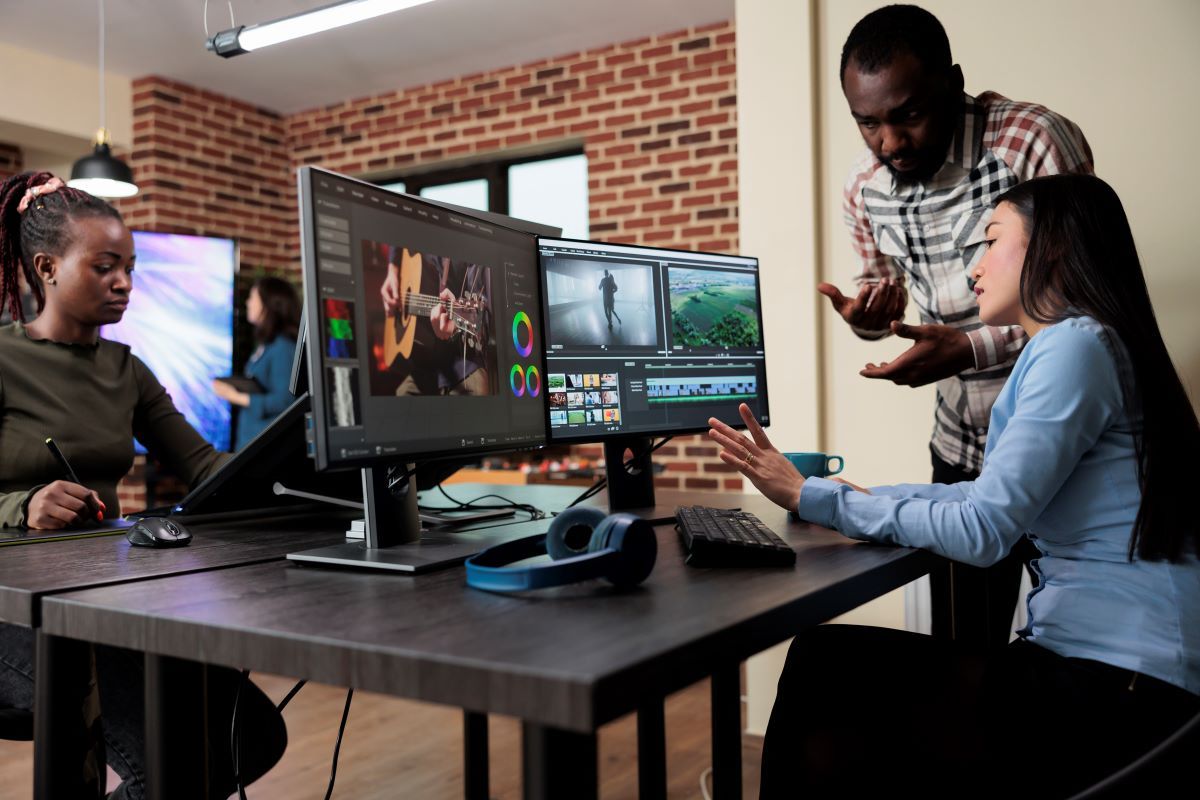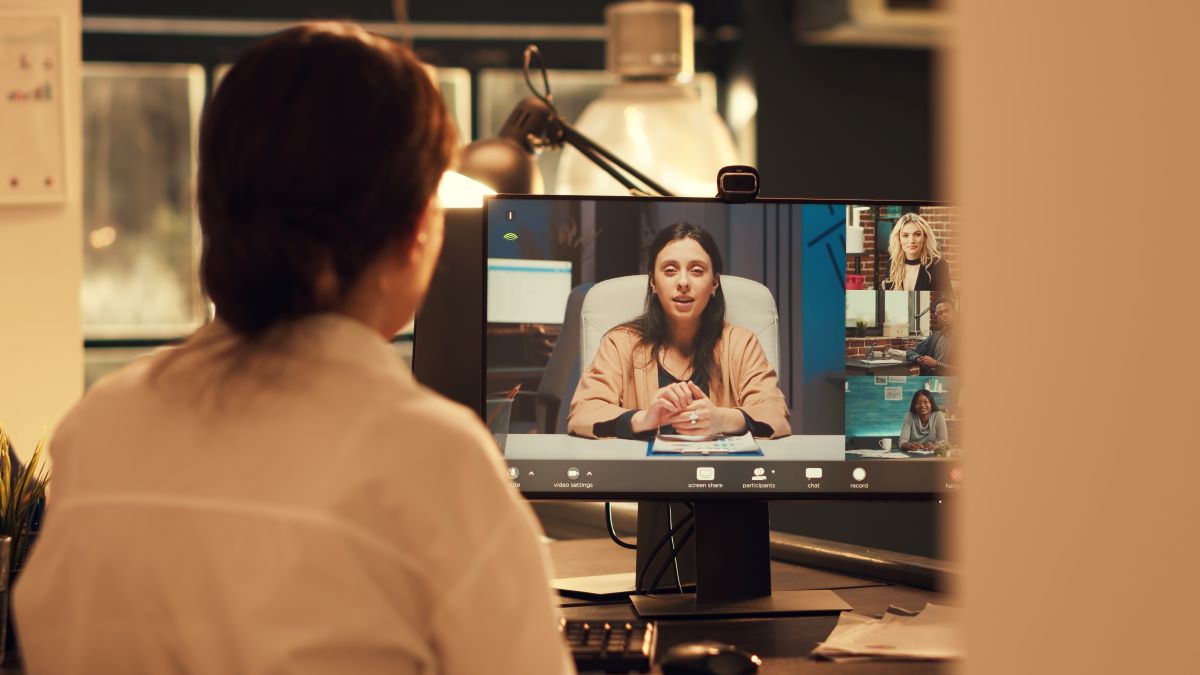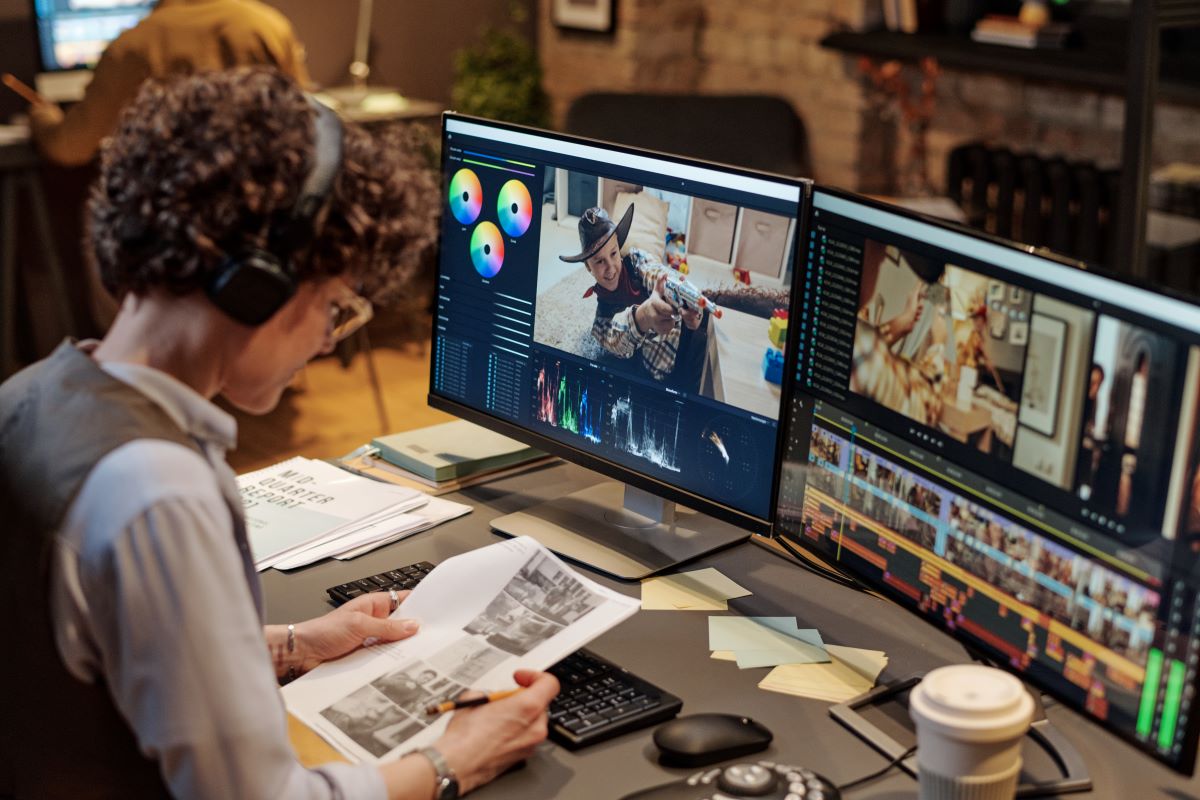Introduction
In today’s filmmaking world, creativity is no longer limited by geography. Directors, editors, writers, and visual artists can now collaborate on a movie project online without ever being in the same room. Whether it’s an indie short film, a feature documentary, or a YouTube mini-series, digital collaboration tools allow teams to plan, produce, and finalize their movies efficiently from anywhere in the world.
When the global film industry faced restrictions during the pandemic, remote collaboration became the norm — and now it’s here to stay. Studios, freelancers, and small teams all use online tools to manage production, share assets, and work on editing in real time.
This guide will take you through a step-by-step workflow, exploring everything from project planning to editing and post-production, ensuring that your next online film project runs smoothly.
Why Online Collaboration Matters in Modern Filmmaking
1. Accessibility and Inclusivity
Online collaboration allows filmmakers to work with diverse talents from around the globe. A director in Los Angeles can easily coordinate with a cinematographer in Berlin and a sound designer in Mumbai.
2. Cost-Effective Production
Remote work reduces costs such as studio rentals, travel, and accommodation. Cloud tools also cut down on the need for physical drives and data transport.
3. Real-Time Feedback
Tools like Frame.io and Vimeo Review make it possible to receive feedback instantly on edits, color grades, or VFX shots — streamlining the revision process.
4. Flexibility and Workflow Efficiency
Working online allows team members to contribute on their schedules, ensuring creativity isn’t restricted by time zones or physical availability.

Understanding the Online Movie Collaboration Workflow
Before diving into the step-by-step process, it’s crucial to understand the stages of a film project that can be managed online.
| Stage | Primary Tasks | Best Online Tools |
|---|---|---|
| Pre-Production | Scriptwriting, storyboarding, scheduling, casting, budgeting | Celtx, Milanote, StudioBinder, Notion |
| Production Planning | Shot lists, call sheets, crew management | Frame.io, Google Sheets, ClickUp |
| Production (Remote Shoots) | Uploading footage, remote direction, daily reviews | Zoom, OBS, Frame.io, Google Drive |
| Post-Production | Video editing, VFX, color grading, sound mixing | Adobe Premiere Pro (Team Projects), DaVinci Resolve |
| Distribution & Marketing | Publishing, social promotion, and analytics tracking | YouTube Studio, Vimeo, Hootsuite |
Step 1: Plan Your Project Structure
A successful online film collaboration starts with clear planning. Define your roles, timeline, and toolset before creating any content.
Define Roles and Responsibilities
Each participant must know exactly what they’re accountable for. Here’s a sample role division:
| Role | Responsibilities | Recommended Tool |
|---|---|---|
| Director | Vision, creative decisions, approving edits | Frame.io, Slack |
| Producer | Budget, scheduling, permissions, communication | Notion, Google Drive |
| Scriptwriter | Writing and revising screenplay | Final Draft, WriterDuet |
| Editor | Syncing, cutting, color correction | Adobe Premiere Pro, DaVinci Resolve |
| Sound Designer | Audio cleanup, sound effects, mixing | Audacity, Pro Tools |
| Marketing Lead | Teasers, social media coordination | Canva, Hootsuite |

Step 2: Choose the Right Collaboration Tools
The heart of any online project lies in the software stack you choose. Since every team has unique needs, selecting the right tools is crucial.
Here’s a breakdown by category:
| Category | Tool Examples | Key Features |
|---|---|---|
| Communication | Slack, Discord, Microsoft Teams | Real-time chat, video calls, channel-based organization |
| Project Management | Notion, Trello, ClickUp, StudioBinder | Task lists, deadlines, Kanban boards |
| File Sharing | Google Drive, Dropbox, Frame.io | Cloud storage, version control, video reviews |
| Editing Collaboration | Adobe Team Projects, DaVinci Resolve Cloud, Frame.io | Collaborative timeline editing, cloud sync |
| Scriptwriting | Celtx, WriterDuet, Final Draft | Cloud-based script editing and version tracking |
| Visual Planning | Milanote, Miro | Mood boards, concept layouts, storyboarding |
Pro Tip
While it’s tempting to use too many tools, keep your ecosystem minimal — ideally one tool per function. Overlapping platforms often confuse team members and slow productivity.
Step 3: Set Up a Shared Workflow
When you collaborate on a movie project online, one of the most important things is establishing a shared workflow that keeps every team member aligned, even if they’re in different time zones.
A good workflow ensures that files are easy to locate, revisions are tracked, and communication remains transparent. Without structure, remote projects quickly spiral into chaos.
How to Build an Effective Shared Workflow
| Task | Action | Recommended Tool or Platform |
|---|---|---|
| Create a shared project folder | Use a structured folder system: /Scripts /Footage /Audio /Edits /Final | Google Drive or Dropbox |
| Version control | Add version numbers or dates to files (e.g., “Scene1_Edit_v3.mp4”) | Frame.io, Notion logs |
| Communication protocol | Set up weekly calls and daily status check-ins | Slack, Google Meet |
| Feedback and approvals | Use timestamped video review tools for comments | Frame.io, Vimeo Review |
| Backup policy | Ensure automatic cloud backup of raw and edited files | Backblaze, Dropbox |
Why File Organization Matters
A well-structured file system prevents loss of crucial data and avoids confusion between team members. Cloud platforms like Google Drive and Frame.io allow granular permissions — letting you share only the necessary files with editors, colorists, or sound engineers.

Step 4: Managing the Production Phase Remotely
Remote film production is one of the trickiest phases to coordinate when you collaborate on a movie project online. However, modern technology now makes it entirely possible to direct shoots, monitor footage, and review performances in real-time — even from thousands of miles away.
How Remote Production Works
| Aspect | What Happens Online | Tools & Techniques |
|---|---|---|
| Remote Directing | Director gives feedback via live video feed | Zoom, OBS, Riverside.fm |
| Daily Footage Uploads | Crew uploads footage daily for review | Frame.io, Dropbox, Google Drive |
| Shot Monitoring | Real-time monitoring using live camera feed | QTake, Teradek Live |
| Communication Hub | Real-time updates and production notes | Slack, Notion, WhatsApp group (backup) |
| Scheduling & Call Sheets | Automatically shared with team across time zones | StudioBinder, ClickUp |
Best Practices for Remote Shoots
-
Establish a daily check-in time for production updates.
-
Use local crew members for physical setups while the director oversees remotely.
-
Maintain internet redundancy (mobile hotspot backup) for smooth streaming.
-
Label every video clip clearly to match the shot list or storyboard.
-
Use a centralized communication hub — avoid scattering messages across platforms.

Step 5: Collaborating in Post-Production
The post-production stage is where true online collaboration shines. Editors, sound designers, and colorists can work on the same project from different locations using synchronized cloud-based editing systems.
1. Cloud Editing and File Management
With Adobe Premiere Pro’s Team Projects and DaVinci Resolve Cloud, multiple editors can work simultaneously on different sequences. The software syncs changes automatically, minimizing overwrites or lost progress.
| Task | How It’s Managed Online | Recommended Tool |
|---|---|---|
| Video Editing | Collaborative timeline editing with shared media assets | Adobe Team Projects, DaVinci Resolve Cloud |
| Color Correction | Cloud-based grading with shared LUTs | DaVinci Resolve, Frame.io integration |
| Sound Design | Import and sync external audio files remotely | Avid Pro Tools, Audacity, Adobe Audition |
| Motion Graphics | Upload motion templates and share previews | After Effects, Canva for quick assets |
| Review & Revisions | Timestamped notes, threaded discussions, approval workflow | Frame.io, Vimeo Review |
2. Effective Version Control
Every exported cut should have a version number and date, and all versions should be stored in a dedicated “Edits” folder. Use color codes (like “Ready for Review,” “Final Cut,” “Approved”) in project management software to visualize progress.
3. Audio & Color Collaboration
When collaborating remotely:
-
Use shared reference monitors to ensure consistent color grading.
-
Use lossless audio formats (like WAV) when sending sound files between editors and mixers.
-
Sync with timecodes to avoid alignment errors in audio and video.

Pro Tip
Before final delivery, host a virtual screening session with all major contributors. This allows creative and technical feedback in real-time and helps finalize small corrections before distribution.
Step 6: Best Tools and Platforms for Online Movie Collaboration
When you collaborate on a movie project online, your tools are the backbone of the entire workflow. Choosing reliable, scalable, and easy-to-use platforms ensures that your creative vision flows smoothly from concept to final export.
Below is a detailed comparison of popular collaboration tools tailored for filmmakers.
Comparison Table: Top Platforms for Remote Filmmaking
| Tool Name | Best For | Key Features | Pricing Model | Ideal Team Size |
|---|---|---|---|---|
| Frame.io | Video review and approval | Timestamped comments, version tracking, Adobe Premiere integration | Free plan + Paid tiers | Small to large teams |
| Notion | Project management | Task boards, notes, database-style tracking, customizable templates | Free + $8/user for Pro | Any team size |
| StudioBinder | Film production management | Call sheets, scheduling, shot lists, crew contacts | Free trial + Subscription | Medium to large film teams |
| Celtx | Scriptwriting and story planning | Real-time collaborative scriptwriting, production breakdown | Subscription | Writers and small studios |
| DaVinci Resolve Cloud | Editing and color grading | Shared projects, real-time collaboration, high-end color tools | Free + Paid Studio version | Post-production teams |
| Dropbox | File sharing and backup | Cloud storage, sync, version history | Free up to 2 GB + Paid tiers | All teams |
| Slack | Team communication | Channels, threads, app integrations, voice/video calls | Free + Paid | Small to mid-size teams |
How to Build the Perfect Tool Stack
When building your online filmmaking ecosystem, don’t just install tools randomly. Follow these key guidelines:
-
Integration is key: Use tools that integrate with your editing software (e.g., Frame.io with Premiere or Resolve).
-
Keep it minimal: Too many tools slow down progress — focus on 4–5 that cover all needs.
-
Ensure file security: Always enable two-factor authentication for cloud storage platforms.
-
Set permissions carefully: Only give editing or download access to trusted collaborators.
Step 7: Maintaining Clear Communication and Creative Alignment
Creative collaboration requires consistent communication — and when you collaborate on a movie project online, that communication must be intentional. Misunderstandings can derail timelines and creative flow, so a structured system keeps the production on track.
1. Daily Communication Framework
| Frequency | Purpose | Platform |
|---|---|---|
| Daily check-ins | Quick progress updates | Slack or Teams |
| Weekly creative meetings | Discuss storytelling, pacing, and visuals | Zoom, Google Meet |
| Monthly milestone review | Evaluate progress, assign next phase tasks | Notion, ClickUp |
| On-demand feedback | Share edits, review shots, color or audio notes | Frame.io or Vimeo Review |
2. Tone and Collaboration Culture
-
Be specific in feedback. Avoid “I don’t like this cut.” Instead, say, “Try tightening this transition between Scene 2 and Scene 3.”
-
Acknowledge contributions. Creative work thrives on positive reinforcement.
-
Avoid chat overload. Keep feedback in organized threads.
-
Use screen recording tools (like Loom) to explain visual feedback clearly.
3. Handling Creative Disagreements
Disagreements are natural — even more so online. Resolve them through:
-
Open discussions via video calls instead of long message threads.
-
Reference-based decision-making (share mood boards, previous edits).
-
Collaborative voting for creative direction among key team members.
Step 8: Organizing Assets and Media Delivery
The larger your project, the more media you’ll accumulate — raw footage, graphics, sound effects, VFX assets, and more. Poor asset management can cause confusion, lost files, and hours of wasted time.
Tips for Efficient Media Organization
-
Use consistent file naming conventions.
Example:Scene03_Take02_CameraA_Date.mp4 -
Keep assets in mirrored folder structures.
(Each department — editing, sound, VFX — should follow the same hierarchy.) -
Create proxy files for large media.
Use lightweight copies for smoother editing in collaborative software. -
Use shared “delivery folders.”
These contain final exports, compressed in proper formats (H.264, ProRes).
| Folder Name | Purpose | Storage Location |
|---|---|---|
| /Scripts | Final and draft versions of the screenplay | Google Drive |
| /Footage | Raw video and backups | Dropbox / Frame.io |
| /Audio | Sound effects, Foley, ADR recordings | Google Drive / Pro Tools Cloud |
| /Edits | Work-in-progress and final cuts | Frame.io / Resolve Cloud |
| /Marketing | Posters, thumbnails, trailers | Canva / Dropbox |
Step 9: Distributing and Promoting the Final Film Online
Once the final cut is approved, the next step is distribution and marketing. This stage is crucial — and it, too, can be fully managed online.
Online Distribution Options
| Platform | Purpose | Best For |
|---|---|---|
| YouTube | Free global distribution, monetization options | Short films, documentaries |
| Vimeo | High-quality streaming and password-protected screenings | Professional screenings |
| FilmFreeway | Submit to festivals worldwide | Indie filmmakers |
| Amazon Prime Video Direct | Reach paid audiences | Independent feature films |
| Reelhouse | Direct sales and rentals | Independent distributors |
Marketing Tips
-
Create short behind-the-scenes clips and share them on Instagram and YouTube Shorts.
-
Use email newsletters to update fans and collaborators about releases.
-
Add SEO-optimized film descriptions using terms like “independent film collaboration” and your focus keyword collaborate on a movie project online for better discoverability.
-
Cross-promote on Reddit filmmaking communities and LinkedIn groups for professionals.
Step 10: Overcoming Common Challenges in Online Film Collaboration
Even the best tools can’t guarantee a perfect collaboration experience. When you collaborate on a movie project online, human factors — communication, time zones, and workflow alignment — often become bigger challenges than the technology itself.
Here’s a breakdown of common obstacles and actionable ways to overcome them.
Table: Common Challenges and Practical Solutions
| Challenge | What It Means | Solution | Recommended Tool/Strategy |
|---|---|---|---|
| Time Zone Differences | Team members work in different countries or regions | Use overlapping “core hours” (e.g., 3-hour shared window for all) | Google Calendar, World Time Buddy |
| Communication Gaps | Misunderstandings or missing updates between departments | Use structured channels for each topic | Slack, Notion |
| Large File Transfers | 4K footage and raw audio files are too heavy for email | Use cloud platforms with resumable uploads | Frame.io, Dropbox, WeTransfer Pro |
| Version Confusion | Multiple edits cause conflicts or overwriting | Set strict version naming and approval workflow | Frame.io, DaVinci Resolve Cloud |
| Creative Disagreements | Differing opinions on story, tone, or color | Use visual references, hold review meetings | Miro, Zoom |
| Data Security Risks | Leaks of unreleased footage or scripts | Use encrypted links and restricted access | Google Workspace, Box Enterprise |
| Motivation Drop | Remote team feels disconnected over time | Celebrate milestones and screen rough cuts together | Virtual screenings, team calls |
Step 11: Maintaining Team Trust and Accountability
A film project, whether online or in person, depends heavily on trust and shared ownership. Without consistent accountability, deadlines slip, and quality drops. When you collaborate on a movie project online, you need systems that create both transparency and motivation.
1. Define Clear Deliverables
Every role should have measurable outcomes. For example:
-
Editor: Deliver a rough cut by Week 2
-
Sound designer: Submit first sound mix by Week 3
-
Marketing lead: Prepare teaser trailer before final cut
Use Notion, ClickUp, or Airtable to track deadlines and progress visually.
2. Use Transparent Progress Tracking
Set up public progress dashboards visible to all members. It keeps accountability high and ensures everyone knows the current project status.
| Department | Task | Status | Owner | Deadline |
|---|---|---|---|---|
| Editing | Scene 1 Rough Cut | In Progress | Maria | Oct 22 |
| Sound | Background Music Draft | Completed | David | Oct 19 |
| Color Grading | Scene 4 | Pending | Lin | Oct 25 |
| Marketing | Social Promo Draft | In Progress | Aiden | Oct 24 |
3. Hold Regular Review Meetings
Even 15-minute weekly sync-ups can prevent misalignment. Encourage video-based communication to strengthen team rapport and reduce isolation.
4. Share Credit Generously
Always credit every contributor properly in film metadata, YouTube descriptions, and festival submissions. Recognition encourages long-term loyalty in remote teams.
Step 12: Ensuring Data Security and Legal Protection
When working remotely, intellectual property and data protection are often overlooked. Your film’s assets — raw footage, scripts, and soundtracks — are your IP, and they must be safeguarded.
Security Best Practices for Online Film Collaboration
-
Use Encrypted Cloud Platforms: Always choose cloud tools that support end-to-end encryption and password-protected sharing.
-
Apply Role-Based Access: Only give editing rights to core members; everyone else gets view-only access.
-
Backup Regularly: Use automatic daily backups on secondary drives or cloud mirrors (e.g., Backblaze).
-
Sign NDAs (Non-Disclosure Agreements): Especially when involving freelancers or external editors.
-
Use Watermarks: For unreleased clips, apply non-intrusive watermarks before sharing online.
| Security Layer | Tool or Method | Purpose |
|---|---|---|
| Encryption | Google Workspace, Proton Drive | Protects files during transfer |
| NDAs | DocuSign, HelloSign | Legal confidentiality |
| Cloud Backups | Backblaze, pCloud | Prevents accidental data loss |
| Version Tracking | Frame.io | Avoids overwriting files |
| Watermarks | DaVinci Resolve, Premiere Pro | Protects early drafts and previews |
Step 13: Building Long-Term Remote Film Teams
Once your first project succeeds, you’ll want to maintain relationships with trusted collaborators for future productions. Here’s how to build a professional online film crew ecosystem:
1. Keep an Updated Talent Database
Use Notion or Airtable to store:
-
Crew member details
-
Contact info
-
Previous roles and achievements
-
Availability for upcoming projects
2. Encourage Portfolio Sharing
Motivate each member to keep a public portfolio or showreel on Vimeo or Behance. This fosters credibility when pitching to clients or investors.
3. Create a Shared Culture
Even remote teams can have a studio-like culture. Celebrate birthdays, project completions, and screenings virtually. Build emotional connections, not just workflows.
4. Continuous Improvement
After each project, host a short postmortem meeting to discuss:
-
What worked well
-
What needs improvement
-
How to optimize future workflows
Document these lessons to streamline your next collaboration.
Conclusion
Collaborating on a movie project online is no longer a futuristic idea — it’s the new normal for filmmakers across the world. From indie creators to production studios, digital collaboration allows teams to bring stories to life without ever stepping into the same room.
By using the right combination of planning, communication, and cloud-based tools, you can seamlessly manage every stage — from scriptwriting to post-production and marketing.
Summary: The Online Movie Collaboration Process
| Stage | Key Actions | Recommended Tools | Goal |
|---|---|---|---|
| Pre-Production | Scriptwriting, scheduling, budgeting | Celtx, Notion, StudioBinder | Build a creative foundation |
| Production | Remote directing, footage uploads | Zoom, Frame.io, Dropbox | Capture and organize footage |
| Post-Production | Editing, color grading, sound design | DaVinci Resolve Cloud, Adobe Team Projects | Craft the final cut |
| Distribution | Uploading, promotion, festival submissions | Vimeo, YouTube, FilmFreeway | Share your story with the world |
In short, when you collaborate on a movie project online, you’re leveraging the power of technology to bridge creativity across continents. All it takes is structure, trust, and the right digital ecosystem.

1. How can filmmakers collaborate on a movie project online?
Filmmakers can collaborate online using a combination of cloud-based tools and real-time communication platforms. Apps like Frame.io, DaVinci Resolve Cloud, and Notion help manage every stage of production — from scripting to editing. Shared cloud folders and live feedback tools allow directors, editors, and sound engineers to work together seamlessly from different locations.
2. What are the best tools to collaborate on a movie project online?
Some of the most effective tools for online movie collaboration include:
-
Frame.io for video review and file sharing
-
Celtx for cloud-based scriptwriting
-
DaVinci Resolve Cloud for remote editing
-
Notion or ClickUp for production tracking
-
Slack for communication
Each tool contributes to better workflow, organization, and version control in filmmaking.
3. Can you edit a movie collaboratively online?
Yes. Collaborative editing tools like Adobe Team Projects and DaVinci Resolve Cloud allow multiple editors to work on the same project simultaneously. Changes are synced automatically in the cloud, so teams can edit footage, add effects, or adjust color grading without overwriting each other’s work.
4. How do you handle large file sharing when collaborating remotely?
To manage large 4K or RAW files, filmmakers use cloud storage solutions like Dropbox, Google Drive, or Frame.io. These platforms offer resumable uploads, version tracking, and secure sharing links. Compressing proxies for editing also reduces transfer times while maintaining workflow speed.
5. What are the biggest challenges in online film collaboration?
Common challenges include:
-
Time zone differences
-
File version confusion
-
Large data transfers
-
Communication gaps
-
Maintaining creative alignment
These can be solved by setting clear file naming conventions, using centralized tools, and scheduling consistent review meetings across the team.
6. Is online movie collaboration secure?
Yes — as long as you use encrypted cloud services and follow security best practices. Always restrict editing permissions, use two-factor authentication, and sign NDAs with collaborators. Platforms like Google Workspace and Frame.io provide enterprise-grade encryption to protect your creative assets.
7. How do online teams stay motivated during long film projects?
Keeping motivation high in remote teams requires intentional communication and recognition. Schedule virtual screenings of rough cuts, celebrate milestones, and maintain transparency in progress tracking. Shared goals and regular feedback foster engagement and a sense of belonging among team members.
8. Can small indie teams benefit from online movie collaboration?
Absolutely. In fact, independent filmmakers gain the most from online collaboration because it reduces costs and increases access to global talent. Even with a small crew, you can manage the entire process using free or low-cost tools like Notion, Google Drive, and Frame.io.
9. How can online collaboration help filmmakers network and find new opportunities?
When you collaborate on a movie project online, you’re not just completing a film — you’re expanding your professional network. Working remotely with editors, writers, and producers from around the world builds relationships that can lead to future partnerships, job offers, and festival collaborations.
For filmmakers looking to grow their circle even further, check out our in-depth guide on Indie Filmmaker Networking Platforms That Actually Work. It lists the most effective communities and online spaces where independent creators can connect, share ideas, and find serious collaborators for upcoming projects.
Final Thoughts
The art of filmmaking has always been about collaboration — and now, thanks to the digital era, that collaboration transcends borders. By following this step-by-step guide and using tools purpose-built for remote teams, you can bring your cinematic vision to life no matter where your collaborators are.
So the next time you collaborate on a movie project online, remember:
You’re not just working remotely — you’re building a creative ecosystem that connects storytellers worldwide.


Leave a comment